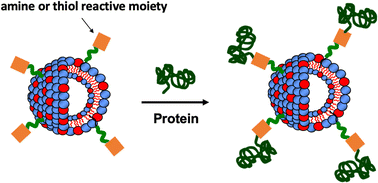Evaluating methods to create protein functionalized catanionic vesicles†
Abstract
Catanionic surfactant vesicles (SVs) composed of sodium dodecylbenzenesulfonate (SDBS) and cetyltrimethylammonium tosylate (CTAT) have potential applications as targeted drug delivery systems, vaccine platforms, and diagnostic tools. To facilitate these applications, we evaluated various methods to attach proteins to the surface of SDBS/CTAT vesicles. Acid phosphatase from wheat germ was used as a model protein. Acid phosphatase was successfully conjugated to vesicles enriched with a Triton-X 100 derivative containing an unsaturated ester. Enzymatic activity of acid phosphatase attached to vesicles was assessed using an acid phosphatase assay. Results from the acid phosphatase assay indicated that 15 ± 3% of the attached protein remained functional but the presence of vesicles interferes with the assay. DLS and zeta potential results correlated with the protein functionalization studies. Acid phosphatase functionalized vesicles had an average diameter of 175 ± 85 nm and an average zeta potential of −61 ± 5 mV in PBS. As a control, vesicles enriched with Triton-X 100 were prepared and analyzed by DLS and zeta potential measurements. Triton X-100 enriched vesicles had an average diameter of 140 ± 67 nm and an average zeta potential of −49 ± 2 mV in PBS. Functionalizing the surface of SVs with proteins may be a key step in developing vesicle-based technologies. For drug delivery, antibodies could be used as targeting molecules; for vaccine formulation, functionalizing the surface with spike proteins may produce novel vaccine platforms.



 Please wait while we load your content...
Please wait while we load your content...